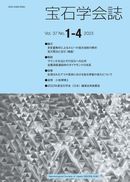Current issue
Displaying 1-13 of 13 articles from this issue
- |<
- <
- 1
- >
- >|
-
2023 Volume 37 Issue 1-4 Pages Cover1
Published: December 25, 2023
Released on J-STAGE: January 25, 2024
Download PDF (1710K) -
2023 Volume 37 Issue 1-4 Pages Cover2
Published: December 25, 2023
Released on J-STAGE: January 25, 2024
Download PDF (957K) -
2023 Volume 37 Issue 1-4 Pages 1
Published: December 25, 2023
Released on J-STAGE: January 25, 2024
Download PDF (968K) -
2023 Volume 37 Issue 1-4 Pages 2
Published: December 25, 2023
Released on J-STAGE: January 25, 2024
Download PDF (997K)
Articles
-
2023 Volume 37 Issue 1-4 Pages 3-10
Published: December 25, 2023
Released on J-STAGE: January 25, 2024
Download PDF (1584K) -
2023 Volume 37 Issue 1-4 Pages 11-12
Published: December 25, 2023
Released on J-STAGE: January 25, 2024
Download PDF (1128K)
Articles
-
2023 Volume 37 Issue 1-4 Pages 13-19
Published: December 25, 2023
Released on J-STAGE: January 25, 2024
Download PDF (1385K) -
2023 Volume 37 Issue 1-4 Pages 20-30
Published: December 25, 2023
Released on J-STAGE: January 25, 2024
Download PDF (2011K)
Short Note
-
2023 Volume 37 Issue 1-4 Pages 31-35
Published: December 25, 2023
Released on J-STAGE: January 25, 2024
Download PDF (1384K)
-
2023 Volume 37 Issue 1-4 Pages 36-40
Published: December 25, 2023
Released on J-STAGE: January 25, 2024
Download PDF (1125K) -
2023 Volume 37 Issue 1-4 Pages 41-66
Published: December 25, 2023
Released on J-STAGE: January 25, 2024
Download PDF (2085K)
-
2023 Volume 37 Issue 1-4 Pages Cover3
Published: December 25, 2023
Released on J-STAGE: January 25, 2024
Download PDF (957K) -
2023 Volume 37 Issue 1-4 Pages Cover4
Published: December 25, 2023
Released on J-STAGE: January 25, 2024
Download PDF (1975K)
- |<
- <
- 1
- >
- >|
